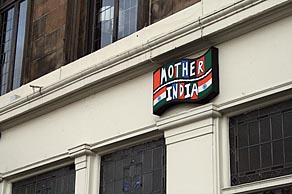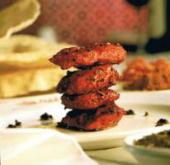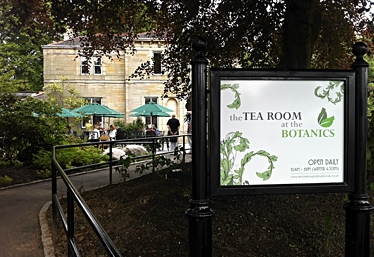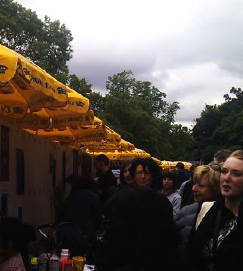A bold wee tribute to a great tradition
Added on Monday 2 Jul 2012
 Sometimes "less is more" where restaurants are concerned - in the sense that a small but perfectly formed venue with loads of individual style can be hugely more impressive than some cavernous dining hall run with grim, mass-catering efficiency.
Sometimes "less is more" where restaurants are concerned - in the sense that a small but perfectly formed venue with loads of individual style can be hugely more impressive than some cavernous dining hall run with grim, mass-catering efficiency.
That's arguably nowhere more true than in the Wee Curry Shop adjuncts to the Mother India stable, which for many years now have been bringing a taste of authentic Asian "village cafe" excellence to the city's exuberantly brilliant Indian restaurant scene.
The Wee Curry Shop at Cowcaddens, for example, is about as intimate and effortlessly splendid setting as you could hope to find anywhere, particularly in the evening when the candles are lit and the fresh aromas start to waft the few feet from the kitchen to the expectant diners.
Consider the ambience of this semi-secret haven of rustic Asian culinary delights and the food it's capable of producing and it's surely forgivable, particularly for those of us with selective memories of the Indian restaurants of yesteryear, to wonder how it took so long for Glasgow to "discover" what many would agree is the real deal.
We can wax nostalgic about the Good Old Days of lager-fuelled revelry in 70's Gibson Street - now, with the closure of the short-lived Gurkha Tandoori, sadly bereft of Asian restaurants - but those curries of yesteryear we thought were amazing were desperately crude by today's soaringly high standards.
So, of course, were many of the customers. It's nice to remember the jolly times of long-haired, flared-trousered youth, but while the likes of the Koh-i-Noor in Gibson Street could boast a galaxy of A-list customers from the BBC, politics and journalism, the "typical" weekend late night customer - as Ashoka founder Charan Gill has recently remarked - was sometimes a less salubrious proposition.
 Indian restaurants were where the weekend binge crowd went to swill lager, consume ferociously hot curries, and insult staff who were working appalling hours for terrible wages - edifying, it wasn't.
Indian restaurants were where the weekend binge crowd went to swill lager, consume ferociously hot curries, and insult staff who were working appalling hours for terrible wages - edifying, it wasn't.
The pubs in those days shut at 10pm, by which time before-the-bell drinks had been thrown down in great haste - preparatory to an inebriated surge towards nearby Indian restaurants.
Then again plenty of other customers were perfectly happy to find themselves directed to a table full of strangers, and even to queue for the privilege of getting a place at a table at all.
Many entered happily into a lifelong love affair with their favourite restaurant, to the point where dishes popular in the early 70's are still on the menu now - because the clientele wouldn't be able to cope with the emotional shock of having to do without their Chicken Madras or Lamb Bhuna.
So it wasn't all good, and it certainly wasn't all bad - and those heady days certainly established in Glasgow a "culture" of Asian dining which could only get even better.
Gradually, almost imperceptibly, a new generation of customers began to realise there was a real cuisine going on behind the over-spicy facade of this one time Saturday night novelty, and - after around 30 or 40 years of continuous evolution - some truly wonderful food began to arrive.
As we never tire of telling people, we've got the best selection of Indian restaurants in Britain. There are fabulous individual restaurants dotted around cities all over the country, of course, but only in Glasgow do you find so many truly great Asian outlets clustered so closely together.
And within that it's a fact most of them are in the West End, where the city's love affair with Indian food really began (even although the actual first Indian restaurant was certainly somewhere "up the town").
Now, in what Asian food aficionados may regard as a brilliant little flourish of commemorative glory, restaurateur Monir Mohammed of Mother India fame has capped his many existing achievements by launching a little big tribute to the whole incredible saga of Glasgow's Asian restaurants.
We're delighted to be able to reveal exclusively to readers that the prosaically named "Glasgow Curry Shop" - Scotland's first and only Indian restaurant tribute venue - is ready to open in Ashton Lane on the site of what had been one of the much-loved Wee Curry Shop trio.
Tucked away at the top of a flight of stairs above ever-popular Irish pub Jinty McGinty's, it's going to be a steadily-expanding story as customers of a certain vintage pass on their own anecdotes of the legendary early days of the Shish, the stygian gloom of the old Himalaya, and the epic Goetterdaemmerung of the old Koh-i-Noor - which famously collapsed into the River Kelvin, luckily after its diners had all safely left the premises.
There are hundreds of stories and recollections good and bad, and many of the most engaging will be retold on storyboards in the restaurant by some of the West End's best-known veteran journalists, but while there's an unmistakeably retro theme to the place - we've been given a sneak preview - there isn't any flock wallpaper, and the cuisine will be in the Mother India vein: there won't be any 1970's vindaloos served on asbestos plates.
Some of the photographs on show will stir memories, however - for example of the Gandhi restaurant in Sauchiehall Street and the long-closed and curiously named Gay Lord restaurant (in fact probably named after a famous London restaurant).
We'll also be reminded of the Creme de la Creme, once the largest Indian restaurant in Europe, of the Taj Mahal, and many other one-time favourites which are now just the stuff of folk memory.
Who ordered the onion bhaji? What is a Bombay Duck (and why is it illegal)? Was it really mandatory to order pakora, chapatis and poppadums - and lots of it - before even looking at the starters; and just how did some of those curries of yesteryear achieve such glorious hues of iridescent red?
These and many other beguiling questions will be more or less satisfactorily answered as diners take their own individual trips down a Memory Lane replete with the fondly-remembered intoxicating aromas of vintage Gibson Street.
We'll have much more on this exciting tribute venture in months to come, but in the meantime if you have a favourite Indian restaurant anecdote from the 70's or even earlier send it on to Pat and we'll do our best to give it pride of place in the restaurant itself.
 Marples Cafe goes live
Marples Cafe goes live
Last year the city council decided to create a new "tea room" in the Botanic Gardens, potentially seating around 100, and ever since then - as we now discover - the venture has been quietly taking shape.
Newly-opened, it's based in a former visitor centre beside some old potting sheds, looks as if vast sums have been lavished on it - and is fronted by what could be one of the most exclusive "sun trap" outdoor patio dining areas in the West End, that is if the sun deigns to shine at some unspecified point in the future.
When the scheme was first mooted we were darkly sceptical about whether a cafe aimed primarily at what I'd call the Miss Marples market - ladies of a certain age enjoying a wee nibble at a scone between horticultural ramblings amid the nasturtiums and begonias - could really hope to prosper in an area seething with cafes and diners of all kinds.
Having had a very quick initial look at what's on offer, though, I think there might be some mileage in it after all.
It won't be for the casual visitor, as the prices are at the steep end for cafe fare, and I imagine the typical spend will be around £10 for a drink and something to eat (for example a basic cappuccino is £2.30, and sandwiches are about £5.50), but for those able to afford it the attractive setting and the drawing room ambience of the cafe building makes for a refreshing change from the average.
A more mid-market proposition would have had to be more like a "canteen", to get the prices very much lower, and that would have been high volume bedlam.
The more posh-like format means that it caters for well-heeled overseas visitors, as much as for locals, there will finally be a place of refreshment worthy of the setting ("It's not a park", as botanists are constantly reminding us - even if nearly everyone living nearby uses it as exactly that).
Gone, meanwhile, is the burger van that used to strike a wholly out-of-synch visual chord outside the hothouse, while near the main entrance the "other" Botanics cafe - actually a van - appears to be doing a roaring trade with its enticing selection of quality burgers, soups, ice cream and more.
However what you won't find at either of these outlets is alcohol, even although the council has for years been desperate to find ways of raking in cash to pay for public amenities, that is over and above the vast fortunes extorted from council tax payers.
It was solidly behind the controversial plan to open a nightclub in the former railway station beneath the park, but - following decisive defeat at the hands of outraged residents and angry international botanists - seems to have accepted that licensed facilities in parks (let alone botanical gardens) are a bridge too far.
The outdoor patio area at the new cafe, with its expensive wrought iron tables and umbrellas, was deserted when I called by - because of course it was the usual summer's day of pelting, unforgiving rain - but indoors a mature crowd of ladies in cashmere jerseys were cheerfully wiring in to Earl Grey and assorted savoury treats.
I guarantee the outdoors bit will be choc-a-bloc on sunny days, and that the twinset and pearl set will reward the city council entrepreneurs' culinary chutzpah by turning up in droves to pay handsomely for the privilege.
Festival triumph
Bumping into genial publican Colin Beattie the other night in, where else, his famous Lismore bar in Partick, reminded me of the West End Festival - not because of anything much that happened in local streets but because of the rapturous report in The Scotsman on the band gigs at Colin's somewhat larger venue, Oran Mor, which made up the last night of the events.
I'll spare you the whole lineup, but They Promised Us Jetpacks were just one of the acts to cause a sensation, and that in a golden evening which showed just how amazing Oran Mor can be when the weather is smiling and the West End is in genial party mood.
Add to the Premier Division attractions there a whole welter of other high quality entertainment in Ashton Lane, all the way downhill to the Three Judges, and there's a strong argument that the "real West End Festival" took place largely in Hillhead and Partick.
But that's just an immediate impression based on the heroic efforts of the local licensed trade in the face of a recession-linked meltdown of the Festival as a whole.
A lot of the cash spent by major sponsors in previous years had vanished, there was virtually nothing - anywhere - to tell you some sort of festival was in progress; and, infamously, there was no kind of parade for the weather to rain on.
Instead, 'though, courtesy of venues including Oran Mor and Cottier's, there was a fantastic mix of entertainment covering the whole spectrum of music and drama in a specifically local way.
 I missed the Gibson Street party, but am told it was the best yet; and I also had to miss Iain Black and co's annual tribute to Lobey Dosser and Bud Neill, staged at and around another excellent West End hostelry - Dram! in Woodlands Road.
I missed the Gibson Street party, but am told it was the best yet; and I also had to miss Iain Black and co's annual tribute to Lobey Dosser and Bud Neill, staged at and around another excellent West End hostelry - Dram! in Woodlands Road.
However last week I did get along to the annual Mela event in Kelvingrove Park, a fantastic event which also helped to make up for the apparent lack of action in the official programme - even if it was a little surprising to see an Andrews Sisters tribute act belting out "Boogie Woogie Bugle Boy of Company B" amid all the sitars and bhangra.
The West End Festival is going through some tough times, in line with the present economic depression, but its star performing venues - and some defiant community spirit - are keeping the flame alive.
Thai's the limit
As far as I know there are just three Thai restaurants in Glasgow at the moment, two of them in the West End, and that may be why England-based chain Chaopraya has decided to take over a gigantic vacant site at the top of Buchanan Street.
I'm told the design fit on this place is "palatial", and an enormous sign outside tells us it's going to be the biggest Thai restaurant in Europe - an amazing claim to fame, if true.
The venture opens this month in what was for many illustrious years the former Royal Scottish Academy of Music and Drama, where I dimly remember anguished piano lessons and even more anguished singing lessons in decades past - and where everyone who was anyone, musically speaking, dropped by to give a tutorial at one time or another.
Now it's to be one very conspicuous local exemplar of a cuisine of which most of us know very little - outside the alleged Thai Green Curries which pop up on aspirational pub menus, and their ready-meal equivalents on supermarket shelves.
There are obviously two main elements to this startlingly vast new arrival on the city centre dining scene - the venue itself, and the cuisine.
From the initial propaganda we have to assume the place is going to be one giant baroque tribute to south-east Asian culture, with conspicuous images of the Buddha making up a central theme.
Some will find that controversial - religious imagery linked to a money-making enterprise centred on food and drink - but I suspect the restaurant will aim to soar above the concept of offering mere "decor", and will have its own inherent dignity ... let's wait and see.
For the cuisine we can turn to what people think of some of the chain's existing ventures in England, as related on a well-known "advisor" site.
I'd treat this with an enormous amount of caution, as basically anybody can say pretty much anything they like about a place, without any great knowledge of cuisine or profound critical judgement to offer - however there does seem to be a broad consensus that Chaopraya is exceptionally good, and not outrageously expensive.
It's not in the West End, of course, but when you consider it's but a very short subway ride to Buchanan Street from St George's Cross, Kelvinbridge, Hillhead or Partick, a venue right on Nelson Mandela Place (close neighbour to Amarone), has to be a serious option for local diners risking that "beyond Charing Cross nosebleed syndrome" to venture into town.
After all, it's something most of us try at least once a year.
Highland fling
Pity the poor staff at famous Partick cask ale pub The Three Judges as they ponder how to acquire, in record time, formal Highland dress for A Big Do in the very week when zillions of graduating students have already nabbed every kilt and sporran in sight.
The pub is a contender in this year's Dram magazine awards under the category Best Poured Pint of Tennent's Lager - which could strike some as a tad ironic, since the bar is best known as an exemplar of quality cask ale rather than standard lager.
However it's a category well worth winning, since if the pub does clinch the title it will prove beyond doubt that it's simply "the best beer pub" on all fronts - from "real" ale to the Big Red T to Bavarian wheat beer, and many other brews besides.
The message is that the same care and attention goes into the production of a pint of Tennent's as into any of the more ostensibly exotic beers on offer, and the beer-fanatic bar staff are - modestly - hoping for a good result.
Win or lose, they've already made the final three and are in any case assured of a great night out amid a proverbial who's who of Scotland's licensed trade - and I hope they find those elusive kilts in time.






